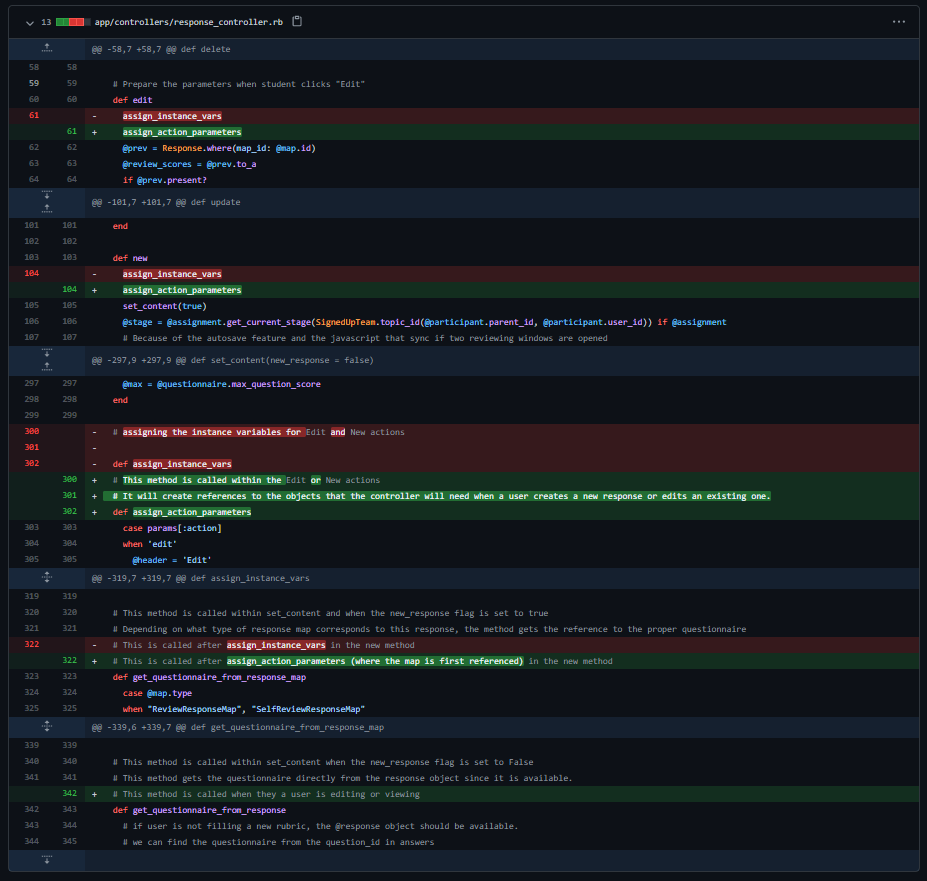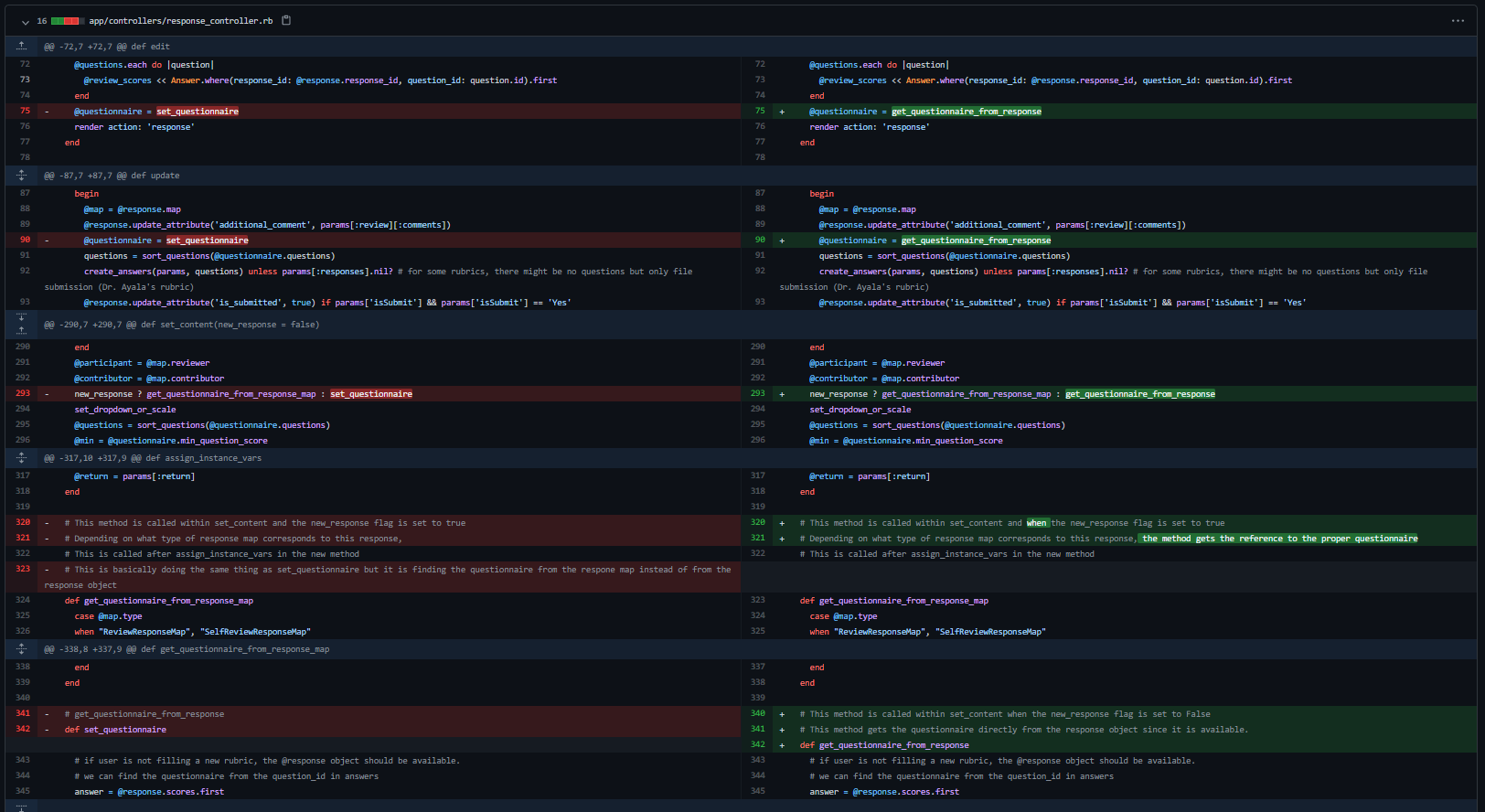CSC/ECE 517 Spring 2021 - E2103. Refactor response controller.rb: Difference between revisions
No edit summary |
|||
| Line 34: | Line 34: | ||
=== METHOD: def scores === | === METHOD: def scores === | ||
This method appears to have been created to replace the code at lines 71-74, however these particular lines of code are never repeated, and any calculation or business logic regarding scoresd should be (and is) in the model, the method scores is not necessary. The method scores was deleted as part of this refactor. | This method appears to have been created to replace the code at lines 71-74, however these particular lines of code are never repeated, and any calculation or business logic regarding scoresd should be (and is) in the model, the method scores is not necessary. The method scores was deleted as part of this refactor. | ||
[[File:Scores.png|1200px]] | [[File:Scores.png|1200px]] | ||
Revision as of 22:07, 19 March 2021
This page details project documentation for the CSC/ECE 517 Spring 2021, "E2103 refactor response_controller.rb" project.
Background
A response is the object that is created when someone fills out a review rubric, such as when one writes a review, gives feedback to a reviewer, or fills out a survey. Responses to the individual rubric items are kept in Answer objects; each Answer object has a response_id to say what Response it is part of. Since response_controller needs to work with many kinds of responses, its code is pretty general. It is not the worst controller in the system, but it would be much clearer if its method names were more descriptive of what they do.
Mentor
Ed Gehringer, efg@ncsu.edu
Team Members
- Zach Parks (zpparks@ncsu.edu)
- Jatin Pramod Chinchkar (jchinch@ncsu.edu)
- Abhinav Kashyap (akashya3)
Issues
- def assign_instance_vars This name could be more specific.
- def scores This should be a model method (in response.rb)! It is all calculation.
- def new This method contains a complicated condition that determines whether the submission has been updated since the last time it was reviewed. If it has not, then the reviewer can edit his/her previous review. If there has been an update, then the reviewer gets a new review form to “update” the review. It would make sense to have a model method that tests whether there has been a review since the last file or link was submitted. Then the code here would just call that function. It would be a lot clearer what the new method is doing. set_content(new_response = false) also plays a role in this calculation. Perhaps this method should also be included in the refactoring, for the sake of clarity of the resulting code.
- def set_questionnaire Badly named; what kind of questionnaire and why? The name should be a lot clearer.
- def set_questionnaire_for_new_response Badly named, no comments, not at all clear. The logic is not like set_questionnaire. Rename, refactor for clarity, and add comments as appropriate.
- def show_calibration_results_for_student This method makes about five db accesses. Can it be broken into 2 methods, with the business logic moved to response.rb?
Refactorization and Code Modifications
Below is a list of code refactor tasks and issues addressed by this team in this project. We have also included any pertinent details, reasonings, comments, warnings, etc., corresponding to each task.
METHOD: def assign_instance_vars
METHOD: def scores
This method appears to have been created to replace the code at lines 71-74, however these particular lines of code are never repeated, and any calculation or business logic regarding scoresd should be (and is) in the model, the method scores is not necessary. The method scores was deleted as part of this refactor.
METHOD: def new
METHOD: def set_questionnaire
The main issue with this method was the naming and poorly commented code, making the purpose and functionality of the method obscure. This method is called whenever a user is editing or viewing a response - in this case, the controller already has access to the particular Response object in question and thus this method is used to get a reference to the questionnaire corresponding to the Response object and question id. Due to the functionality and because it requires access to a Response object already, this method was renamed to get_questionnaire_from_response. Comments were added to clarify its functionality.
METHOD: def set_questionnaire_for_new_response
Again, the main issue with this method was the name and poorly commented code. This method has similar, but not the same, functionality as the set_questionnaire (get_questionnaire_from_response) method, except this method is called when a user is creating a new Response object, thus the controller does not have access to the Response object in question. In this case, it is possible to get a reference to the appropriate questionnaire by using the ResponseMap object instead of the Response object. This method was subsequently renamed to get_questionnaire_from_response_map and the code was commented to clarify its functionality.
METHOD: def show_calibration_results_for_student
Tests
To run the tests :
rspec spec/models/response_spec.rb
Since we are just dealing with the Response MVC and testing methods only in Model. We will be writing all our tests in spec/models/response_spec.rb
- Insert Snapshot





